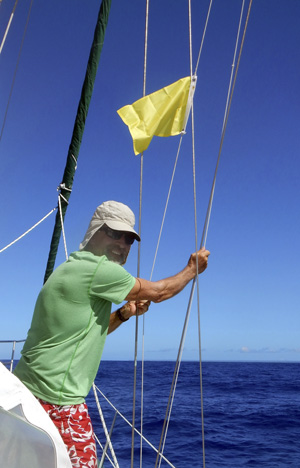Published in the Ocean Watch column, Honolulu Star-Advertiser © Susan Scott
June 9, 2014
What happened with the customs officer in Tonga?” a reader emailed, referring to a comment I made in last week’s column about a misunderstanding Craig and I had after arriving in that country by sailboat. “Perhaps other cruisers would like to know so they don’t make the same mistake.”
 Craig raising the quarantine flag, 2014.
Craig raising the quarantine flag, 2014.
If only it were that simple. Countries’ entry and exit laws regarding foreign boats can be as hard to get right as sailing there in the first place.
It’s easy to read a country’s official policies online and in cruising guides. But because sailing schedules are ruled by the weather, boats sometimes arrive, or must leave, on weekends, holidays and during off hours. Often it’s not clear what to do at those times.
In addition, not all workers are up to date on their governments’ latest regulations. And even if they are, some officials view the check-in and checkout procedures more as guidelines than laws.
In 2006, for example, after arriving in the Cook Islands on a Sunday, I followed protocol and insisted that my crew stay aboard, at anchor, until Monday. After a difficult, upwind passage, this was like a jail sentence.
By Monday, however, after my radio calls went unanswered and no one came, we inflated the dinghy and went to the harbor’s administrative center.
“You should have come ashore,” the exuberant customs officer said when I told him when we arrived, “and enjoyed our beautiful island (Aitutaki)!”
Other workers toe the official line. Last month we arrived in Vavau, Tonga, on Maundy (Holy) Thursday. Warned in Niue that everything in these devoutly Christian nations would be closed until Tuesday, we asked the locals who helped tie the boat to the entry dock what do to.
“Go there,” two men said, pointing to a nearby building.
Wrong building. A harbor official drew us a map to another building six blocks away. Wrong again. When we got back, an angry customs officer was at the boat.
“No one leaves the boat before being cleared!” he said. “Where did you go?”
The officer scolded us as we explained, apologized and groveled. Eventually the hand-drawn map convinced him that we had been misled, and he started us on our trek through Tonga’s customs, immigration, quarantine and health clearances, each division with its own inspector, forms and fees.
We were lucky. Customs officers can fine you, impound your boat or have you arrested.
Leaving a country by boat can be as tricky. In Suva it took us no less than four visits, each 2 miles round trip, walking, to the immigration office to check out. But the Fijian workers were so cheery about the time mix-ups — Oops, lunch time. Three o’clock? Sorry, we meant 6 — all we could do was laugh. Besides, after being on a 37-foot boat for most of a month, exercise felt good.
Worldwide, when arriving at a foreign port, vessels must request clearance by flying a yellow quarantine flag. It seems straightforward enough, but seasoned sailors know that hoisting a Q flag often signals the beginning of another memorable experience.
But having memorable experiences is why we go cruising.